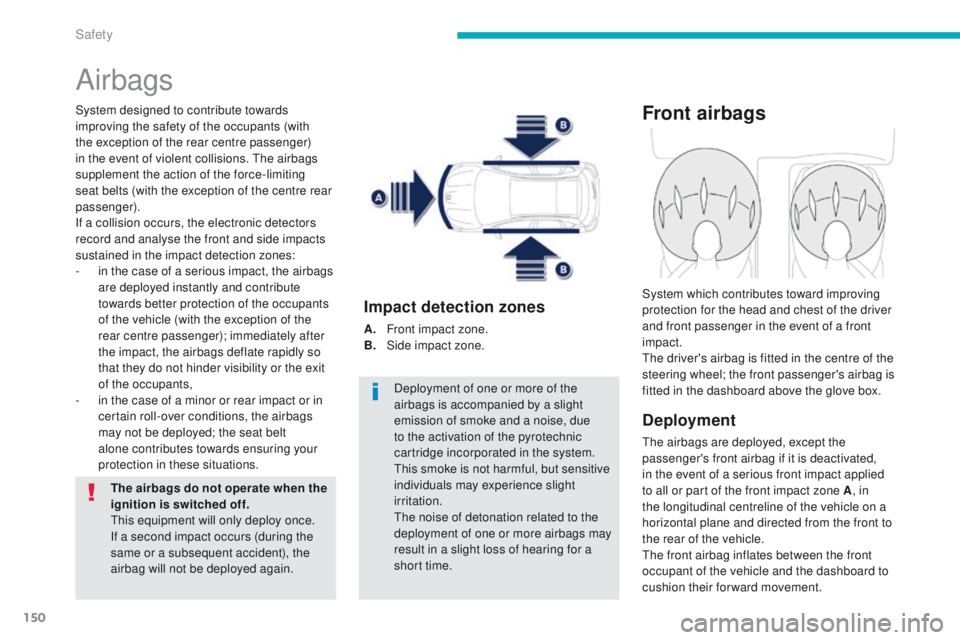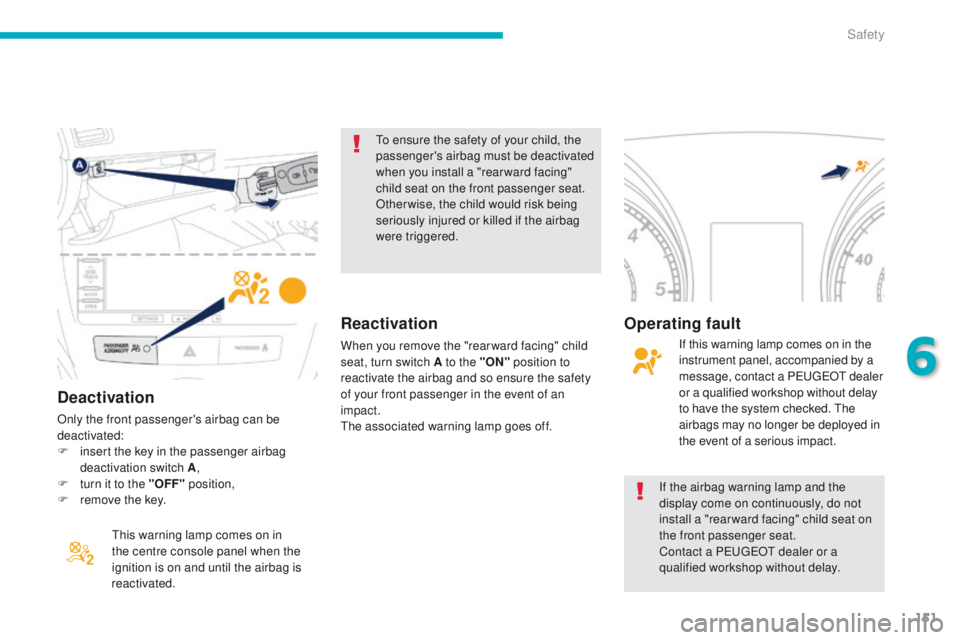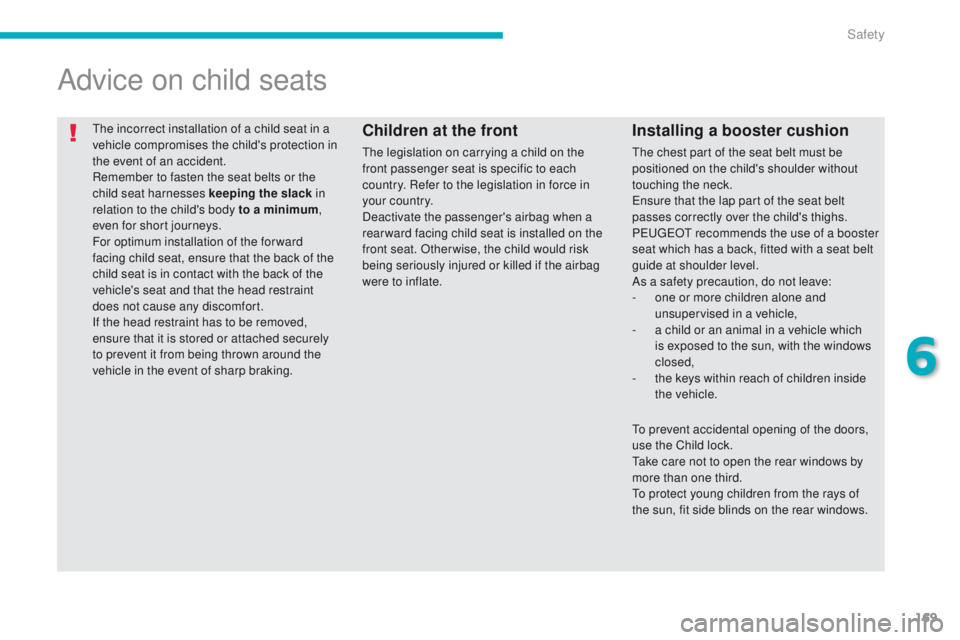Page 152 of 389

150
Airbags
System designed to contribute towards
improving the safety of the occupants (with
the exception of the rear centre passenger)
in the event of violent collisions. t
h
e airbags
supplement the action of the force-limiting
seat belts (with the exception of the centre rear
passenger).
If a collision occurs, the electronic detectors
record and analyse the front and side impacts
sustained in the impact detection zones:
-
i
n the case of a serious impact, the airbags
are deployed instantly and contribute
towards better protection of the occupants
of the vehicle (with the exception of the
rear centre passenger); immediately after
the impact, the airbags deflate rapidly so
that they do not hinder visibility or the exit
of the occupants,
-
i
n the case of a minor or rear impact or in
certain roll-over conditions, the airbags
may not be deployed; the seat belt
alone contributes towards ensuring your
protection in these situations.
The airbags do not operate when the
ignition is switched off.
th
is equipment will only deploy once.
If a second impact occurs (during the
same or a subsequent accident), the
airbag will not be deployed again. Deployment of one or more of the
airbags is accompanied by a slight
emission of smoke and a noise, due
to the activation of the pyrotechnic
cartridge incorporated in the system.
th
is smoke is not harmful, but sensitive
individuals may experience slight
irritation.
th
e noise of detonation related to the
deployment of one or more airbags may
result in a slight loss of hearing for a
short time.
Impact detection zones
A. Front impact zone.
B. S ide impact zone.
Front airbags
Deployment
the airbags are deployed, except the
passenger's front airbag if it is deactivated,
in the event of a serious front impact applied
to all or part of the front impact zone A , in
the longitudinal centreline of the vehicle on a
horizontal plane and directed from the front to
the rear of the vehicle.
th
e front airbag inflates between the front
occupant of the vehicle and the dashboard to
cushion their forward movement. System which contributes toward improving
protection for the head and chest of the driver
and front passenger in the event of a front
impact.
th
e driver's airbag is fitted in the centre of the
steering wheel; the front passenger's airbag is
fitted in the dashboard above the glove box.
Safety
Page 153 of 389

151
Deactivation
Only the front passenger's airbag can be
deactivated:
F
i
nsert the key in the passenger airbag
deactivation switch A ,
F
t
urn it to the "OFF" position,
F
r
emove the key.
th
is warning lamp comes on in
the centre console panel when the
ignition is on and until the airbag is
reactivated.
to e
nsure the safety of your child, the
passenger's airbag must be deactivated
when you install a "rear ward facing"
child seat on the front passenger seat.
Otherwise, the child would risk being
seriously injured or killed if the airbag
were triggered.
If the airbag warning lamp and the
display come on continuously, do not
install a "rear ward facing" child seat on
the front passenger seat.
Contact a P
e
uge
Ot
dealer or a
qualified workshop without delay.
Reactivation
When you remove the "rear ward facing" child
seat, turn switch A to the "ON" position to
reactivate the airbag and so ensure the safety
of your front passenger in the event of an
impact.
th
e associated warning lamp goes off.
Operating fault
If this warning lamp comes on in the
instrument panel, accompanied by a
message, contact a P
e
uge
Ot
dealer
or a qualified workshop without delay
to have the system checked.
t
h
e
airbags may no longer be deployed in
the event of a serious impact.
6
Safety
Page 158 of 389
156
Child seat in the front*
Rearward facingForward facing
When a rear ward facing child seat is installed
on the front passenger seat, adjust the seat
to the intermediate longitudinal and highest
position, with the backrest straightened.
the
passenger airbag must be deactivated.
Otherwise, the child would risk being
seriously injured or killed if the airbag were
to inflate . When a for ward facing child seat is installed on
the front passenger seat
, adjust the vehicle's
seat to the intermediate longitudinal and
highest position with seat backrest straightened
and leave the passenger's airbag activated.
*
R
efer to the current legislation in your country
before installing a child seat on this seat.
Passenger seat adjusted to the intermediate
longitudinal position.
en
sure that the seat belt is correctly
tensioned.
For child seats with a support leg,
ensure that the support leg is in stable
contact with the floor. If necessary,
adjust the passenger seat.
Safety
Page 164 of 389
162
Locations for child seats secured using the seat beltIn accordance with european regulations, this table indicates the options for installing child seats secured using a seat belt and universally approved (a)
in relation to the weight of the child and the seat in the vehicle.
Seat Weight of the child and indicative age
Less than 13 kg
(groups 0 (b) and 0+) Up to ≈ 1 year From 9 to 18 kg
(g r o u p 1)
From 1 to ≈ 3 years From 15 to 25 kg
(group 2)
From 3 to ≈ 6 years From
22 to 36 kg
(group 3)
From 6 to ≈ 10 years
Front passenger seat (c) with
passenger airbag activated X
XXX
Front passenger seat (c) with
passenger airbag deactivated L1
L2, L3 XX
Outer rear seats
(row 2) (d) U
UUU
Centre rear seat
(row 2) (d) L1
L2, L3 XX
Safety
Page 171 of 389

169
the incorrect installation of a child seat in a
vehicle compromises the child's protection in
the event of an accident.
Remember to fasten the seat belts or the
child seat harnesses keeping the slack in
relation to the child's body to a minimum,
even for short journeys.
For optimum installation of the forward
facing child seat, ensure that the back of the
child seat is in contact with the back of the
vehicle's seat and that the head restraint
does not cause any discomfort.
If the head restraint has to be removed,
ensure that it is stored or attached securely
to prevent it from being thrown around the
vehicle in the event of sharp braking.
Advice on child seats
Installing a booster cushion
the chest part of the seat belt must be
positioned on the child's shoulder without
touching the neck.
en
sure that the lap part of the seat belt
passes correctly over the child's thighs.
P
e
uge
Ot
recommends the use of a booster
seat which has a back, fitted with a seat belt
guide at shoulder level.
As a safety precaution, do not leave:
-
o
ne or more children alone and
unsupervised in a vehicle,
-
a c
hild or an animal in a vehicle which
is exposed to the sun, with the windows
closed,
-
t
he keys within reach of children inside
the vehicle.
Children at the front
the legislation on carrying a child on the
front passenger seat is specific to each
country. Refer to the legislation in force in
your country.
Deactivate the passenger's airbag when a
rear ward facing child seat is installed on the
front seat. Otherwise, the child would risk
being seriously injured or killed if the airbag
were to inflate.
to p
revent accidental opening of the doors,
use the Child lock.
ta
ke care not to open the rear windows by
more than one third.
to p
rotect young children from the rays of
the sun, fit side blinds on the rear windows.
6
Safety